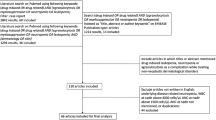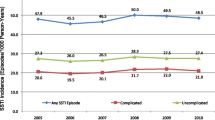Abstract
Sweet syndrome (SS) is divided into malignancy-associated, classical, and drug-induced subtypes. Features associated with SS, such as fevers, neutropenia, and cancer, are also high risk for serious infection. We aimed to describe hospitalized patients with a documented concern for SS on initial dermatologic evaluation, their risk of infection, and the impact of SS subtype on treatment and outcomes. We descriptively analyzed hospitalizations at The Ohio State University evaluated for SS by dermatology and performed a retrospective cohort analysis of malignancy-associated and non-malignancy-associated SS patients. Eighty-seven patient hospitalizations were evaluated for SS from 2012 to 2019. Thirty-one hospitalizations were complicated by neutropenia. Lesions in 12.9% (n = 4/31) of neutropenic hospitalizations were infected with Fusarium species (n = 2) or methicillin-resistant staphylococcus aureus (n = 2). One patient with fungal disease died within 30 days of hospitalization. Thirty-three patients were confirmed to have a final diagnosis of SS. In the confirmed SS cohort, malignancy was associated with greater overall dapsone use (p = .021), less initial (p = .046) and overall (p = .013) corticosteroid use, and fewer SS-related readmissions within one year (p = .020) and overall (p = .004). Corticosteroid treatment delay should be considered for a short period in neutropenic patients while excluding infection. Malignancy-associated SS patients were more frequently treated with dapsone and favorable outcomes were seen in cancer patients.

Similar content being viewed by others
Availability of data and material
The datasets generated and/or analyzed during this study are available from the corresponding author on reasonable request and pending appropriate institutional approval for data sharing.
Code availability
Not applicable.
References
Merlant M, Lepelletier C, Battistella M et al (2021) Acute myeloid leukemia and myelodysplastic syndrome-associated Sweet’s syndrome: a comparative multicentric retrospective study of 39 patients. J Am Acad Dermatol 84(3):838–840
Rochet NM, Chavan RN, Cappel MA, Wada DA, Gibson LE (2013) Sweet syndrome: clinical presentation, associations, and response to treatment in 77 patients. J Am Acad Dermatol 69(4):557–564
Nelson CA, Noe MH, McMahon CM et al (2018) Sweet syndrome in patients with and without malignancy: a retrospective analysis of 83 patients from a tertiary academic referral center. J Am Acad Dermatol 78(2):303-309.e4
Nelson CA, Stephen S, Ashchyan HJ, James WD, Micheletti RG, Rosenbach M (2018) Neutrophilic dermatoses: pathogenesis, Sweet syndrome, neutrophilic eccrine hidradenitis, and Behçet disease. J Am Acad Dermatol 79(6):987–1006
Francisco CRI, Patal PC, Cubillan EA, Isip-Tan IT (2011) Sweet’s syndrome associated with Hashimoto’s thyroiditis. BMJ Case Rep. https://doi.org/10.1136/bcr.02.2011.3921
Medeiros S, Santos R, Carneiro V, Estrela F (2008) Sweet syndrome associated with Hashimoto thyroiditis. Dermatol Online J 14(9):10
Su WPD, Liu HNH (1986) Diagnostic criteria for Sweet’s syndrome. Cutis 37(3):167–174
von den Driesch P (1994) Sweet’s syndrome (acute febrile neutrophilic dermatosis). J Am Acad Dermatol 31(4):535–556
Walker DC, Cohen PR (1996) Trimethoprim-sulfamethoxazole-associated acute febrile neutrophilic dermatosis: case report and review of drug-induced Sweet’s syndrome. J Am Acad Dermatol 34(5 Pt 2):918–923
Morris AJ, Byrne TC, Madden JF, Barth RL (1996) Duration of incubation of fungal cultures. J Clin Microbiol 34(6):1583–1585
Gonzalez Santiago TM, Pritt B, Gibson LE, Comfere NI (2014) Diagnosis of deep cutaneous fungal infections: correlation between skin tissue culture and histopathology. J Am Acad Dermatol 71(2):293–301
Hörnsten P, Keisu M, Wiholm BE (1990) The incidence of agranulocytosis during treatment of dermatitis herpetiformis with dapsone as reported in Sweden, 1972 through 1988. Arch Dermatol 126(7):919–922
Funding
No funding was received for this article.
Author information
Authors and Affiliations
Contributions
Conceptualization: BK and MR; Data collection: MW and MR; Analysis: MR and BK; Writing—original draft preparation: MR; Writing—review and editing: BK, MW, JT, and CC; Supervision: BK.
Corresponding author
Ethics declarations
Conflict of interest
Dr. Benjamin Kaffenberger is an investigator for AnaptysBio Inc, Biogen, InflaRx, OnQuality Pharmaceuticals, and Eli Lilly Co and is funded by the Dermatology Foundation.
Ethical approval
Reviewed and approved by The Ohio State University IRB Study ID #2020H0276.
Consent to participate
Not applicable.
Consent for publication
Not applicable.
Additional information
Publisher's Note
Springer Nature remains neutral with regard to jurisdictional claims in published maps and institutional affiliations.
Rights and permissions
About this article
Cite this article
Ravi, M., Waters, M., Trinidad, J. et al. A retrospective cohort study of infection risk in hospitalized patients evaluated for Sweet syndrome. Arch Dermatol Res 314, 967–973 (2022). https://doi.org/10.1007/s00403-021-02318-8
Received:
Revised:
Accepted:
Published:
Issue Date:
DOI: https://doi.org/10.1007/s00403-021-02318-8




